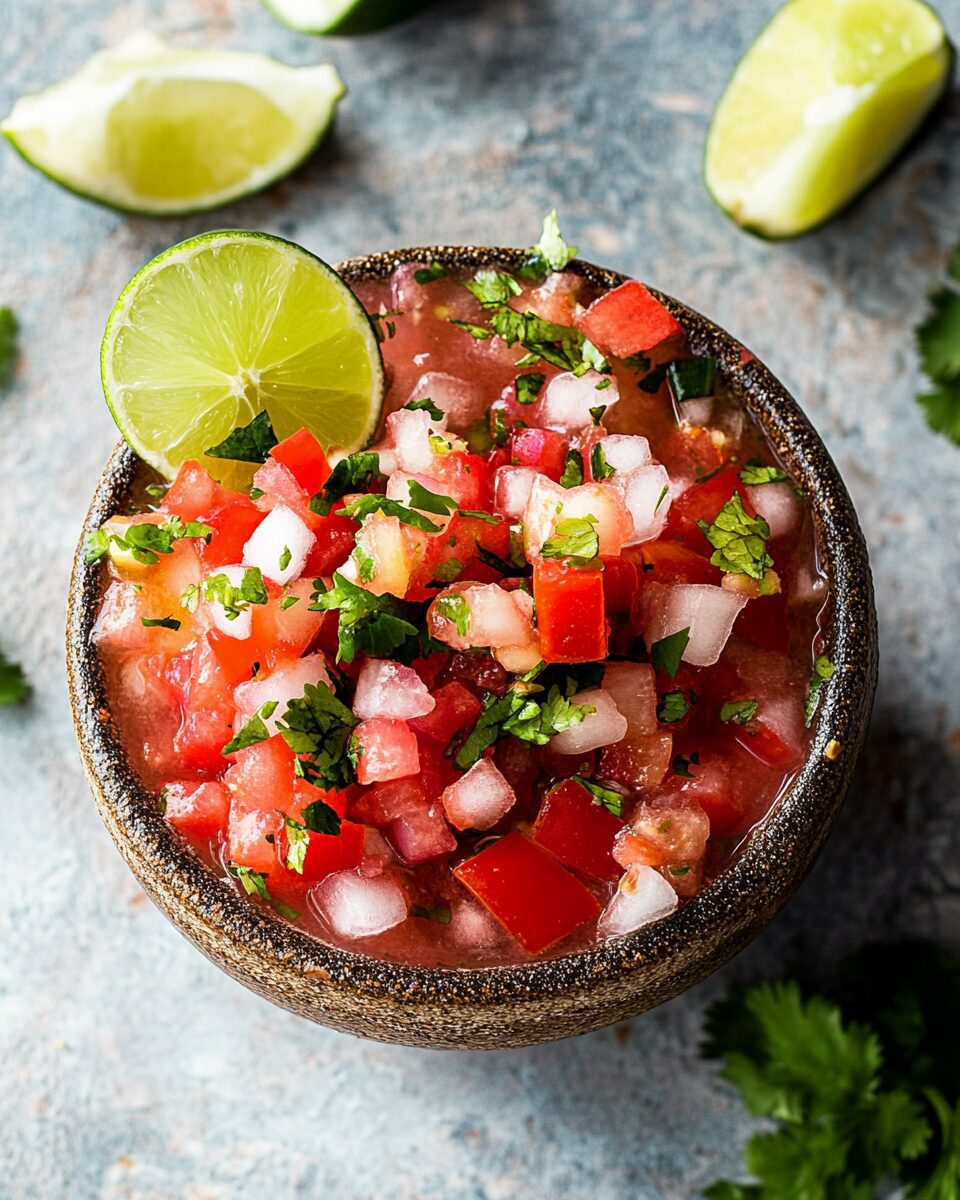This Pico de Gallo recipe is the ultimate fresh salsa experience. With ripe tomatoes, zesty lime, crunchy onions, fiery serrano chiles, and a generous sprinkle of cilantro, it’s bold, bright, and full of flavor. You’ll love how easily it comes together in one bowl with just a few ingredients—and zero cooking time!
Whether you’re serving it with tortilla chips at your next party, spooning it over tacos, or using it as a topping for grilled fish, this versatile salsa is an instant flavor upgrade. Plus, it’s naturally gluten-free, vegan, low-fat, and loaded with garden-fresh goodness. Keep it chilled and let the flavors marry for the best result!
Full Recipe:
-
1½ lbs yellow or red tomatoes, seeded and chopped
-
1 small onion, chopped
-
½ cup chopped fresh cilantro leaves
-
3 tablespoons fresh lime juice
-
2 serrano chiles, seeded and minced
-
Pinch of kosher salt
-
Freshly ground black pepper to taste
Directions:
-
In a medium bowl, combine chopped tomatoes, onion, cilantro, lime juice, serrano chiles, salt, and pepper.
-
Toss all ingredients gently until fully mixed.
-
Cover the bowl and refrigerate for at least 30 minutes before serving to allow flavors to meld.
-
Serve chilled with chips or use as a topping for tacos, grilled meats, or salads.
Prep Time: 10 minutes | Inactive Time: 30 minutes | Total Time: 40 minutes
Kcal: Approx. 25 kcal per ½ cup | Servings: 6 servings (about 3 cups total)
A Deep Dive into Pico de Gallo: Mexico’s Fresh and Flavorful Salsa
Pico de Gallo, often referred to as salsa fresca or salsa cruda, is a quintessential Mexican condiment celebrated for its freshness, simplicity, and bright, bold flavors. This iconic dish is a staple in traditional Mexican cooking and has made its way into kitchens around the world thanks to its versatility and vibrant taste. At its core, Pico de Gallo is a raw salsa composed of chopped fresh tomatoes, onions, cilantro, lime juice, and chiles—each ingredient playing a critical role in the balance of heat, acidity, and crunch.
What sets Pico de Gallo apart from other salsas is its chunky texture and freshness. Unlike cooked or blended salsas, Pico de Gallo is never cooked and is always served cold, making it incredibly refreshing and perfect for warm weather or as a bright contrast to rich dishes.
The Cultural Roots of Pico de Gallo
The origins of Pico de Gallo stretch deep into Mexican culinary tradition. The name itself is colorful and a bit enigmatic. Literally translated as “rooster’s beak,” some say the dish earned this title because it was traditionally eaten by pinching the ingredients between the thumb and forefinger, mimicking the shape of a rooster’s beak. Others suggest that the finely chopped texture of the salsa resembles bird feed. Regardless of the etymology, its significance in Mexican households is profound.
Pico de Gallo is commonly used across various regions of Mexico, with subtle local variations. Some areas may incorporate fruits like mango or watermelon, while others might switch the chile variety depending on what’s available. However, the classic version—featuring tomatoes, onions, cilantro, lime, and chile—remains the most universally recognized.
Flavor Profile and Balance
What makes Pico de Gallo so beloved is the harmony of flavors and textures it provides. The acidity of the lime juice brightens the sweetness of ripe tomatoes, while the onions contribute a sharp bite. Cilantro offers herbal freshness that balances out the heat from serrano or jalapeño chiles. The result is a flavor bomb that enhances everything it touches.
Its crunchy texture adds another dimension to dishes, especially when paired with soft foods like tacos or grilled fish. Unlike smooth salsas, the diced components of Pico de Gallo retain their integrity, allowing each bite to deliver a slightly different taste experience.
Health Benefits and Dietary Appeal
One of the reasons Pico de Gallo has become so popular globally is due to its health-conscious nature. It’s naturally low in calories, fat-free, gluten-free, and vegan, which means it appeals to a broad range of dietary preferences. Each ingredient brings its own set of nutritional benefits:
-
Tomatoes are rich in antioxidants like lycopene, which has been linked to heart health and reduced cancer risk.
-
Onions contain quercetin, an anti-inflammatory compound known for its immune-boosting effects.
-
Cilantro is a detoxifying herb with antimicrobial properties.
-
Chiles, especially serrano or jalapeño, can boost metabolism thanks to the capsaicin they contain.
-
Lime juice offers a healthy dose of vitamin C and aids in digestion.
When combined, these ingredients form a powerhouse of nutrition in a single bowl—perfect for clean eating without compromising flavor.
Culinary Uses and Pairings
Pico de Gallo is incredibly adaptable. While it’s most often served with tortilla chips as a dip, that’s just the beginning. It can be used to add zest and brightness to a wide array of dishes:
-
Tacos and burritos: A spoonful of Pico de Gallo adds freshness and crunch to meaty or cheesy fillings.
-
Grilled meats and seafood: Its acidic notes cut through fatty cuts or smoky grilled flavors beautifully.
-
Salads and bowls: Add it to grain bowls, green salads, or even as a dressing alternative.
-
Egg dishes: Top your scrambled eggs, omelets, or huevos rancheros with a scoop for a spicy morning kick.
-
Sandwiches and burgers: Replace or complement traditional condiments with this chunky salsa for a gourmet twist.
Another great aspect is how easily it can be modified. You can add avocado for creaminess, cucumber for extra crunch, or even fruits like pineapple for a sweet contrast. This flexibility makes it a go-to in both home kitchens and restaurant menus.
Storage and Preparation Tips
Although Pico de Gallo is best consumed fresh, it can be stored in the refrigerator for up to 3-4 days. However, due to the raw nature of the ingredients and the moisture content of tomatoes, it will start to release liquid and lose some of its crunch over time.
To keep it as fresh as possible:
-
Use firm, ripe tomatoes. Avoid overly juicy or soft ones, which can turn the salsa watery quickly.
-
Chop ingredients uniformly. This ensures even distribution of flavor and a better texture.
-
Season at the end. Adding salt too early can draw moisture from the tomatoes prematurely.
-
Let it rest. While you don’t want it sitting too long, giving it 30 minutes in the fridge before serving helps the flavors meld together.
Variations Across Regions and Households
Though the basic formula remains the same, variations of Pico de Gallo are found across Mexico and even Central and South America. Some of the more notable twists include:
-
Fruity Pico de Gallo: Mango, watermelon, and pineapple versions add a tropical flair and are excellent with grilled shrimp or fish.
-
Corn Pico de Gallo: Adding charred or fresh corn provides sweetness and texture.
-
Cucumber Pico: Perfect for a refreshing summer side, especially alongside spicy dishes.
In some families, the choice of chile can vary widely—from mild jalapeños to fiery habaneros—allowing for a customizable heat level. Others might prefer more onion or double down on cilantro. It’s truly a dish that reflects the personality and palate of the person making it.
A Modern Culinary Staple
The global culinary scene has embraced Pico de Gallo not just as a garnish or side, but as a featured flavor in fusion cuisine. Chefs now use it to top everything from poke bowls to fusion tacos, gourmet toast, and more. Its appeal lies in its universal flavor balance—it can brighten up a heavy dish, add texture to something soft, or provide a raw, refreshing element in otherwise rich meals.
What’s more, the rise of plant-based eating and interest in nutrient-rich, whole foods has given Pico de Gallo new life among health-conscious cooks. With its raw ingredients and clean profile, it’s the epitome of “eating the rainbow.”
Conclusion: Why Pico de Gallo Belongs in Every Kitchen
Pico de Gallo is more than just a salsa—it’s a celebration of freshness, tradition, and flavor. With deep cultural roots, a short ingredient list, and limitless versatility, it’s a staple that deserves a permanent place in your culinary repertoire.
Its ability to elevate both traditional Mexican dishes and contemporary global cuisine makes it indispensable for home cooks and chefs alike. Whether you’re hosting a party, meal prepping for the week, or just looking to add flavor to your plate without the extra calories, Pico de Gallo delivers every single time.
Try experimenting with different chile levels, herb ratios, or complementary ingredients to make it your own. But no matter how you spin it, Pico de Gallo is proof that sometimes, the simplest recipes are the most powerful.





